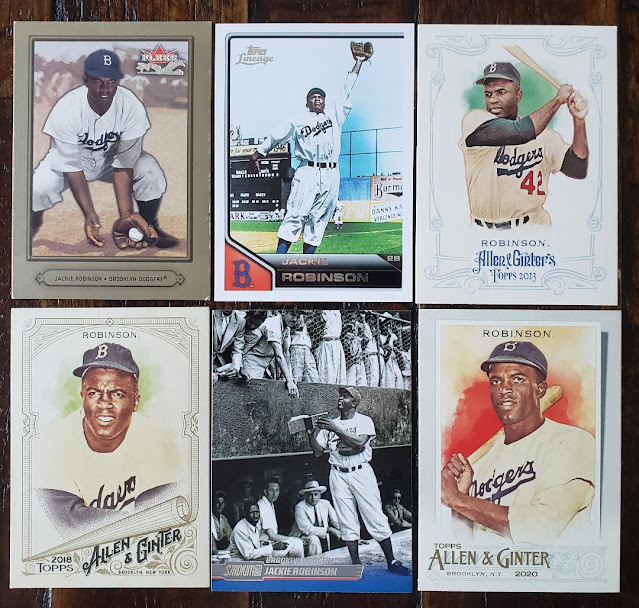I'm doing Jackie Robinson stuff the day after Jackie Robinson Day.
I feel like a bad Dodger fan for that, but yesterday I just wanted to eat and watch baseball, and I'm not together enough to have posts scheduled a week ahead of time (or even a day ahead of time), so we're extending the JR love for another day.
As far as I know, the first card of Jackie Robinson to appear with his uniform number on the back as the card number was the 1997 Topps card of him, which showed up in the middle of the base set, looking very unlike any other card. I'm sure that was weird -- I wouldn't know, I wasn't collecting.
Since that time, the number 42 has been used for Robinson cards repeatedly. Here are just a few:
So we've gotten to the point of knowing that Robinson is probably going to show up at card No. 42 somewhere in some set, probably for the rest of time -- or for as long as Topps has the rights to Robinson's image.
But as a Dodger fan I got curious about other Dodgers showing up at card No. 42. Did it happen a lot?
Oh yes it did.
Here are just some of the players who have had card No. 42 while wearing a Dodger uniform: Hideo Nomo, Omar Daal, Eric Gagne, Shawn Green, Burt Hooton, Fred McGriff, Gary Sheffield, Steve Sax, Max Muncy, Nomar Garciaparra, Andruw Jones, Raul Mondesi, Corey Seager, Russell Martin, Jeff Shaw, Don Drysdale, Sandy Koufax, Julio Urias, Reggie Williams, Adrian Beltre, Kaz Ishii, Edwin Rios, Albert Pujols, Andre Ethier, Zach McKinstry, Tom Candiotti, Darryl Strawberry, Jay Howell.
Most of the number 42 action has happened in the last 25 years but I don't know if any card company consciously placed a Dodger at No. 42 prior to Robinson's 1997 appearance. I like to imagine, though, that they did at some point, just so I can pretend that there was a forward-thinking card company employee.
Anyway, here are a few Dodger notable No. 42s, that are not Jackie:
In the final year of Jackie Robinson's career, Topps' card No. 42 was of a Cuban native who the year prior had helped save the Dodgers' 1955 World Series victory with a running Game 7 catch (that also was the first part of double play) that remains one of the most famous plays in WS history.
Roy Campanella, one of the first African-American ballplayers to reach the majors after Robinson broke the barrier, has appeared as card No. 42 long after his death. But the first Dodgers Black catcher to land 42 was Campy's successor in 1958.
We're still sticking with teammates of Robinson. Koufax was a hard-throwing wild man during Jackie's final years but by 1963 he was doing stuff -- a no-hitter per year -- that no one else had ever done. Fleer put Koufax at card No. 42 with one of the best cards issued during his career.
Another early beneficiary of Robinson's pioneering feat, Don Newcombe was the first great African-American pitcher in major league history. Pacific thought well enough of him in 1990 to use Robinson's number for Newcombe's card number but then spelled Newk's name wrong.
One of the favorite cards of my childhood, this is one of those cards that I could collect repeatedly and turn into a one-page -- or one-binder -- tribute/obsession. The darkened background has always been the appeal of this card, along with the action shot, but it took me years to realize that was Wrigley Field ivy contributing to the appearance.
I write about this card too much on this blog. Yes, I still love it. And now that I know it's No. 42, there's another reason for me to yammer about it.
Don Drysdale was a 19-year-old rookie on the Dodgers during Robinson's final year. That must've been quite the head trip for him.
Dodgers detractors enjoyed pointing out the lack of Black players on the team during their recent World Series run, as if the franchise had to defend itself, given its history. There are simply far fewer Black players in the majors now (I'm happy to see a couple more on the Dodgers this year). Back in 1993, the Dodgers featured Darryl Strawberry, Eric Davis, Lenny Harris, Tom Goodwin, Mike Sharperson, Jose Offerman, Pedro Astacio and the Martinez brothers.
Also, Robinson's legacy is more than giving African-American players a chance, it's about the Latin players and Asian players, etc., etc. The Dodgers know a little about giving those groups opportunities, too.
Yes! I found a Ron Cey card at No. 42. It goes on the list!
The most recent Dodger No. 42 in a Topps flagship set. Bellinger is spending this weekend playing against the Dodgers. It's weird.
Strangely, I could not find a No. 42 for Mookie Betts. Hopefully Topps corrects that soon.
I also briefly looked at all of the No. 42s for Topps flagship sets from the 1950s through 1990. A couple appropriate ones are Earl Wilson (1965), Terry Harper (1969), Tito Fuentes (1970) and Tommy Davis (1972).













Comments
That is a great card
I remember watching the game, I believe Dodgers at Mets on April 15 1997, when it was announced that his number would be retired. It was classy that the last guy to wear the number was Mariano Rivera who played with such class and also could thank Jackie for the chance to play in the bigs.
For another famous 42 card number, the 1984 topps traded card of Doc Gooden. A year later, that card would cost you the same as two credit hours at a local community College. Not so much today.
Paul t